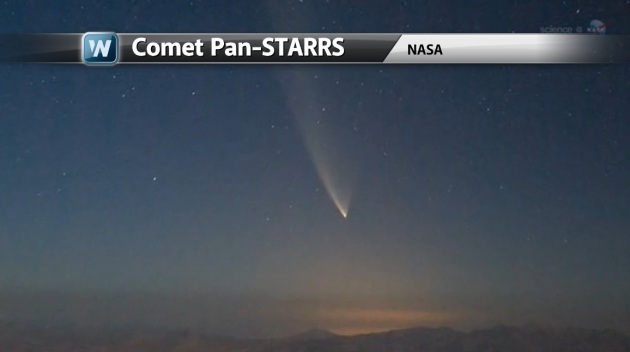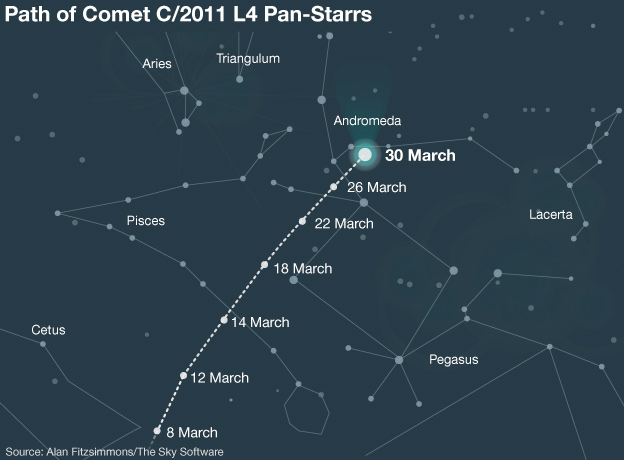Archive for March, 2013
Comet Spotting – Attempt #3
Last night we went out again to try and find Comet Pan-Starrs as it was a clear night, but unfortunately, we didn’t manage to see it. There was a band of cloud along the horizon where I am sure the Comet would have been, and it was also very frosty so the atmosphere of the Earth wasn’t as clear as it had been the previous nights when we have been out. It was a bit of a shame, but we at least saw the Comet on our second attempt which was great!
Instead last night, we had a look around at the other objects in the Sky with our binoculars. Jupiter was very bright and you could see a couple of it’s Moon’s shining beside it, and we also had a good look at the Pleiades (also known as the ‘Seven Sisters’ as they are a group of seven stars that shine very brightly. The Pleiades were clear as a bell through the binoculars and were a great site! Finally, we had a go at looking for the Orion Nebula and that was showing really well. You could see a blurry, but large, mass of stars which make up the Nebula in the sword of the Constellation Orion (just south of Orion’s belt). It was a great view!
So whilst we were annoyed we couldn’t see the Comet again, we had a good time looking at some of the other features that make up the night sky!
Comet Spotting – Attempt #2 – SUCCESS!
After not being sure if we would make it out this evening due to Kelly being ill all last night and this morning and the strange weather that we have had today (rain, sleet, hail and snow!), we did manage to go out, and I am very glad that we did as we spotted the Comet!! 😉
Instead of going to Jenny Cliff, we made the shorter journey up to Shaugh Prior on Dartmoor, as we knew of a good vantage point there, and arrived shortly after sunset (about 18:30 with sunset being 18:18). The Moon was a lot higher in the Sky tonight than last night, and a lot easier to spot as it was a much brighter crescent. So we had a good look around it but couldn’t see anything to start with and it took about 25-30 minutes to spot anything remotely that looked like a Comet.
When I did finally spot something, the object that I saw was very slowly moving across the Sky horizontally and in the general area of where we thought the Comet ought to be. It also had a very long but dark smoky tail but the head of it didn’t have any lights or a brightness to it. We honestly didn’t (and still don’t) know what this object was – it definitely wasn’t an Airplane – it looked more like a meteor to me but who knows!!
At about 19:10 I decided to have one final look (it was absolutely freezing cold) and just had a general scan of the Sky underneath and around the Moon, and finally spotted it! It was very faint and to the lower right of the Moon (not to the lower left as on previous nights) but it was unmistakeable. You could see the head of the Comet being lit up by the Sun and the long tail reaching out behind it almost vertically. We couldn’t see the twin tail unfortunately, but we were very glad that we finally saw it after nearly giving up! It was a very exciting 10-15 minutes looking at it (whilst a Tawny Owl was calling in the nearby trees which did make it a bit creepy though!).
Here is an image from NASA that looks almost exactly the way we saw it, although it wasn’t quite as bright as this tonight.
Tomorrow is the last day of decent weather for the next few days, so we will be going out again to Shaugh Prior to have another look. Am hoping we will get an even better view of it! 😉
Comet Spotting – Attempt #1
We were so close to spotting the C/2011 L4 Pan-Starrs Comet tonight at Jenny Cliff! Unfortunately, just as it started to get dark enough, and the very faint, thin crescent moon appeared, it clouded over!!! The weather said it was meant to be a clear night! Arrrggghh!!
It turned out that we weren’t the only people parked up in Jenny Cliff car park, as several other people of all ages were there as well with their binoculars and cameras, hoping to get a good view! From overhearing their conversations, it seemed that they had all been their the night before and got a good view of the Comet. Lucky people!!
Have just had a look at the weather for tomorrow and it is meant to be clear again, so we will be up there at Jenny Cliff again tomorrow, hoping to catch a glimpse of the ‘once in a lifetime’ Comet! 😉
C/2011 L4 Pan-Starrs Comet
The second Comet this year will be lighting up our skies over the next few nights. This one, named C/2011 L4 Pan-Starrs, was visible using binoculars or a telescope from the 8th March and will become brightest on the 10th March with the best days to view it being on the 12th and 13th as it is in a great place in the Sky to be able to pick it out. At this point, provided it is a clear sky, you should be able to see it with the naked eye.
It should be pretty straightforward to spot as it is close to the crescent Moon in a western direction. To find the Comet, find the Moon just after sunset, and look down and slightly to the left of it. With binoculars you should see the head of the comet very clearly and even the two types of tails coming from it. As the month rolls on, the Comet will appear higher and higher in the sky and later in the evening until it disappears when we reach the month of April.
Comet C/2011 L4 Pan-Starrs was first discovered in June 2011 and is believed to originate from the Oort Cloud. It was picked up in Hawaii by the Pan-Starrs telescope, which is why they have given the Comet its name. Scientists believe that this could be the first time it has appeared in our system as they believe it is a non-periodic Comet, and it may not return for another 100,000 years. So it is definitely a once in a lifetime Comet!!
The Comet itself is thought to have a nucleus of about 20-30KM in diameter but due to the dust and material surrounding it, it could well span more than a million kilometres which is insane to think about in my opinion!
Professor Mark Bailey, director of the Armagh Observatory in Northern Ireland, has said this about the new Comet, “We have great hopes for this comet. Of course we are always very cautious – even now we don’t know how bright it is going to get – but we are keeping out fingers crossed.”
He also said, “After sunset, scan the horizon roughly in the western direction. On the 12 and 13 March, there is a nice association with the thin crescent Moon. You can use the Moon as a guide, and search just down or to the left of the Moon. Through binoculars you should be able to see the head of the comet and certainly the two types of the tail. I would always advise people to hunt for comets with binoculars, but if you have found it with binoculars, have a good hunt around and see if you can see it with the naked eye. That’s quite a challenge – but it is a wonderful thing to have seen.”
Below is an image of the path of the Comet in our night sky in March, so enjoy Comet hunting over the next couple of days and weeks.
Let me know if you see it by either leaving a comment here or tweeting me at @strethewey #nightskyastronomy.

